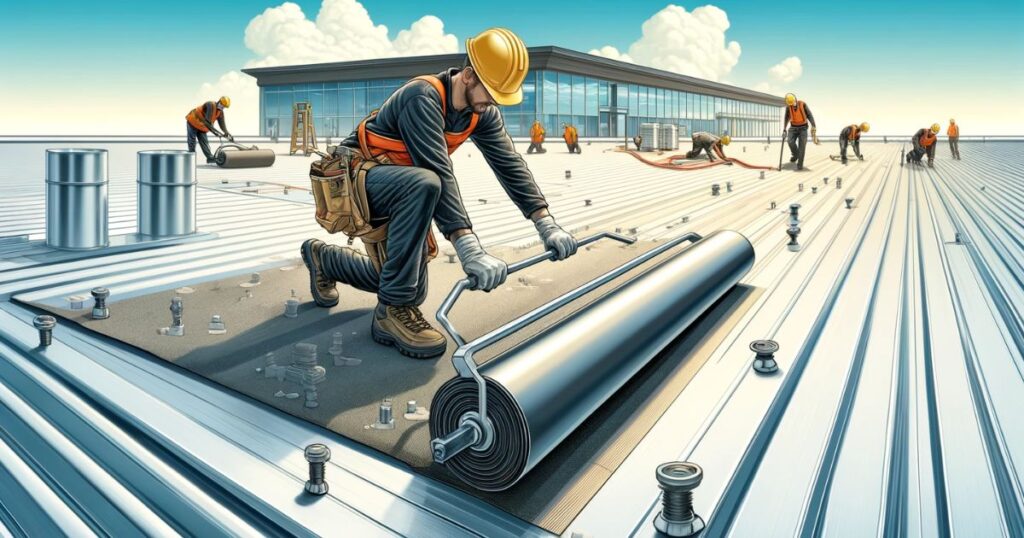
What Is Peel and Stick Roofing?
Peel and stick roofing is an innovative roofing solution that provides superior waterproofing and durability compared to traditional roofing materials. It is a type of roll roofing with a self-adhesive backing, making installation more efficient and eliminating the need for open flames or adhesives.
This system is particularly popular for low slope roofs, where traditional asphalt shingles may not be suitable. With an added thick layer for durability, it offers water shield protection that can withstand extreme weather conditions, making it an ideal choice for both residential and commercial properties.
Flintlastic® SA Cap by CertainTeed – A True Peel and Stick Option
For those considering peel and stick roofing, Flintlastic® SA Cap by CertainTeed is a leading product in the roofing industry. This stick roll roofing system offers a seamless, self-adhering solution that provides long-term protection.
Varner Roofing is 5-star certified with CertainTeed, ensuring expert installation and product knowledge for homeowners and businesses looking to invest in a high-quality roofing system.
The Multi-Ply System – What You Need to Know
Unlike some other roofing materials, which may use a single layer, peel and stick roofing is typically installed as part of a 2- or 3-ply system. This enhances its durability and performance over time.
Key Components of the Multi-Ply System:
- Base sheet installation – Requires a roof deck with a secure base sheet, installed using button cap nails for a strong foundation.
- Multiple layers for reinforcement – The thick layer in a modified bitumen system ensures a long-lasting roofing product.
- Better than single-layer options – Multi-ply installation makes it more resilient than standalone stick membrane systems.
How Peel and Stick Roofing Works
A proper installation involves:
- Laying down a base sheet that adheres to the roof deck with button cap nails.
- Applying the peel and stick membrane firmly onto the base layer.
- Using an 80 lb roller to activate the adhesive and ensure full contact with the roofing materials.
- Over time, heat activation enhances the seal, creating a waterproof barrier.
This self-adhesive backing ensures that the entire roof has uniform protection against water infiltration, extending the roof’s lifespan.
Benefits of Peel and Stick Roofing
Peel and stick roofing provides numerous benefits, making it a superior choice in many applications:
- Easy installation – The self-adhesive backing eliminates the need for hot tar or torches.
- Waterproofing properties – Acts as an advanced water shield, keeping moisture from penetrating the roof deck.
- Durability in extreme weather conditions – Resistant to heavy rains, strong winds, and fluctuating temperatures.
- Works with other roofing materials – Can be used alongside asphalt shingles or as part of a full re-roofing project.
- Ideal for commercial and residential applications – Suitable for both low slope roofs and flat roofing structures.
- Enhanced curb appeal – A seamless look with superior longevity.
Why Choose Peel and Stick Roofing Over Other Low Slope Options?
When compared to rubber roofing and other traditional low slope roof systems, peel and stick roofing offers superior durability and cost-effectiveness.
- More Affordable – Peel and stick systems are typically cheaper than rubber roofing, offering a long-lasting solution at a lower overall cost.
- Better Durability – The multi-ply structure and thick layer make it stronger than single-layer rubber membranes.
- Easier Installation – Unlike rubber roofing, which requires adhesives or mechanical fasteners, self-adhesive backing makes installation simpler and more efficient.
- Superior Waterproofing – The water shield effect in peel and stick roofing prevents leaks better than traditional stick membrane options.
For homeowners and commercial property owners, peel and stick roofing is a smarter long-term investment, offering the best balance of cost, durability, and performance compared to rubber roofing and other low slope roofing materials.
Drawbacks and Considerations
While peel and stick roofing has many advantages, it also requires proper installation to avoid common issues:
- Requires a professional installer – Roof flashing details must be handled correctly to prevent leaks.
- Not ideal for steep slopes – Works best on low slope roofs or flat structures.
- Initial cost vs. long-term value – While the upfront cost may be higher, the extended lifespan makes it a cost-effective choice over time.
Varner Roofing’s Expert Advice: It’s best to leave installation to a trusted professional who understands the complexities of roofing products, ensuring a secure and watertight result.
Understanding the Old Mod-Bit System
Traditional modified bitumen (mod-bit) roofing was once the go-to solution for commercial properties. It required open-flame application and was labor-intensive compared to modern stick roll roofing.
Today, peel and stick roofing provides a more efficient and reliable alternative, offering:
- Better water resistance
- Easier application with self-adhesive backing
- More environmentally friendly options
With these advancements, many property owners are choosing peel and stick roofing over older systems.
Is Peel and Stick Roofing Right for Your Property?
Before selecting a roofing material, consider factors such as:
- The slope of your roof
- Local weather conditions
- The need for enhanced waterproofing
- Budget and long-term maintenance costs
Whether you’re looking to re-roof or install a new stick membrane, Varner Roofing provides expert guidance and certified installation services.
Frequently Asked Questions
1. How does peel and stick roofing compare to ice and water shield?
While both peel and stick roofing and ice and water shield offer waterproofing benefits, they serve different purposes. Ice and water shield is typically used as an underlayment beneath asphalt shingles to prevent ice dams and water infiltration, especially in colder climates. Peel and stick roofing, on the other hand, is a complete roofing system that replaces traditional roofing materials and provides full waterproof protection for low slope roofs.
2. Can peel and stick roofing be installed over an existing roof?
In some cases, peel and stick roofing can be applied over an existing roof, but it depends on the condition of the current roof deck and whether the roofing industry regulations allow it. A clean, solid surface is necessary for the self-adhesive backing to bond properly. If the existing roof is damaged or has loose materials, it’s best to remove it before installation for optimal performance.
3. Is peel and stick roofing suitable for extreme weather conditions?
Yes! Peel and stick roofing is designed to handle extreme weather conditions, including heavy rain, strong winds, and even fluctuating temperatures. The thick layer and modified bitumen composition provide superior durability, and the membrane firmly bonds to the surface over time, creating a highly water-resistant seal that protects against leaks and moisture damage.
Get Expert Help From Varner Roofing
Considering peel and stick roofing for your home or commercial property? Varner Roofing is a 5-star CertainTeed-certified contractor proudly serving communities across Maryland, Virginia, and Pennsylvania, including Hagerstown, Greencastle, Gettysburg, Waynesboro, and Frederick. With local service pages tailored to your area, we make it easy to find trusted roofing solutions near you. Contact us today for a free consultation, and let’s match you with the best peel and stick roofing system for your needs.


